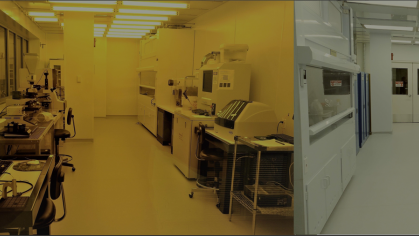The Rutgers CyroEM & Nanoimaging Facility (RCNF) preserves biological specimens in their native state by vitrification; images them at the nanoscale through cryo-transmission electron microscopy (cryo-TEM), cryo-scanning electron microscopy (cryo-SEM), or cryo-focused ion beam microscopy (FIB/SEM); and reconstructs three-dimensional information through computational analysis of these nanoscale images through techniques like single-particle analysis (SPA) and cryo-electron tomography (cryo-ET).
Find a Core Facility
Core facilities play an integral role in our research infrastructure, empowering researchers to break new ground by offering specialized laboratories with state-of-the-art equipment, unique instrumentation and shared services managed by scientists with the technical expertise and experience to help others.
There are two types of Rutgers research core facilities. Centrally-managed core facilities are managed by the Office for Research and Locally-managed core facilities are managed by local units include schools, centers, or institutes. Centrally-managed core facilities are indicated in red text below the facility name.
Filter
-
Key Resources Cryo-electron microscopy; cryo-electron tomography; Titan Krios; Arctica; Aquilos; cryo-FIB; single particle; correlative light microscopy/electron microscopy (CLEM); ion beam.Location New Brunswick/PiscatawayContact Name Jason KaelberContact Email jason.kaelber@rutgers.edu
-
RUBIC was built with a $1.82 million grant from the National Science Foundation in 2010 and is affiliated with the Psychology Department and the Center for Molecular and Behavioral Neuroscience. This first grant allowed RUBIC to purchase a Siemens Trio. A second grant for $1.48 million from the National Science Foundation in 2019 allowed RUBIC to buy a Siemens Prisma.
RUBIC enables researchers from the Rutgers campuses as well as those from nearby institutions (e.g., Kessler Foundation, UMDNJ, etc.) to develop new research strategies and increase understanding of brain processes underlying typical functioning (e.g. human development, learning and memory, perceptual dynamics, neuroeconomics, computational neuroimaging) as well as atypical functioning such as that associated with developmental problems, mental illness, and addiction. Research at RUBIC is supported at present by various agencies and foundations including NSF, NIH, NIDA, NEI, and the James S. McDonnell Foundation.
Key Resources- RUBIC Imaging Suite-Key In addition to the magnet room, RUBIC also has available rooms available to prep experiments, interview participants, and work on data.
- RUBIC offers two 3T scanners for use with both humans and animals, Siemens Trio and Siemens Prisma
- RUBIC Storage and Servers- ORTHANC dicom server, 170T of storage for archiving data, all data is archived for 1 year on RUBIC servers. All data should be transferred preferably within a week or the day of acquisition. Computational analysis for Brain Connectivity measures available using IMaGES and other causal graphical methods. Compute cluster: Intel Xeon E5-2650 CPUs,55 threads, 512GB RAM, and two NVIDIA P100 GPUs
- Eyetracking- An Eyelink-1000 is available for the collection of eye movement data while scanning.
- Physiological Recording-A BIOPAC MP150 system is available for recording skin conductance. Other modules for recording cardio and respiratory data can be added.
- Stimulus Presentation-E-Prime 2.0 is available as well as open source options such as PsychoPy
- Response Acquisition- A number of fiber optic response options are available including response pads and trackballs.
Location NewarkContact Name Stephen Jose HansonContact Email jose@rubic.rutgers.edu -

The School of Engineering (SoE) Nanofabrication Core Facility offers measurement instrumentation, wet processes and majority of process tools for a range of research activities. The core objectives of the Facility include supporting research activities of Rutgers School of Engineering, educating students and postdocs with skills and capabilities that can be readily applied in high-tech semiconductor industries and research institutes, promoting research collaborations between research centers and industrial organizations, bringing in Research Incomes through Grants, User Access Fee and Trainings and leading the applications of federal and state-funded competitive fundings.
Key Resources- Fabrication Tools: Atomic Layer Deposition, Ebeam #1, Ebeam #2, MOCVD, PECVD_Plasma Therm, PECVD_Unaxis, Reactive Ion Etch, Reactive Ion Etch, Rapid Thermal Anneal, Sputter_Denton-DV502, Sputter_Sys & Des Fab, Sputter_Denton, Furnace_Boron, Furnace_Phosphorus, Furnace_Oxidation, Furnace_Anneal/FGA, Plasma Treatment_Barrel Etcher, UVozone Cleaner, Dicing Saw_Disco, Dicing Saw_K&S, Laser Scribing, Marking and Ablation (Innotech), Thermal Evaporator (Logitek), Wafer Spin Rinse Dryer, Photoresist Spinner (Laurel), Mask Aligner (Karl-Suss MJB3)
- Wet Chemical Process: Silicon Etch (HF:HNO3), Silicon Etch (TMAH), Silicon Surface Texturing (TMAH), Caro Etch (H2SO4:H2O2), Aluminum Etch (H4PO4:HNO3:CH3COOH), RCA Clean (NH3:H2O2:H2O, HCL:H2O2:H2O), Palladium Etch (CH3COOH:HNO3:HCL), Boiling HNO3 for oxide growth, Buffered Oxide Etch, Silver Etch (HNO3), Oxide/Nitride Etch (HF fume)
- Characterization Tools:Detek Non-Contact Profilometer, 4-Point-Probe (Ossila), Film Metric, Optical Microscope, UV & Solar Simulator, Scanning Electron Microscope
Location New Brunswick/PiscatawayContact Name Ngwe ZinContact Email ngwe.zin@rutgers.edu -
A Core Facility has been established in Foran Hall on the George H. Cook Campus that will enable students and faculty and outside users to have access to instrumentation whose purchase and maintenance costs would be cost prohibitive for any one investigator. The instrumentation offered at the Core Facility is grouped according to applications and include Bio-imaging, Bio-sensing, Flow cytometry, Real-time PCR, and High throughput screening.
Key Resources Bio-imaging; Bio-sensing; Flow Cytometry; Real-time PCRLocation New Brunswick/PiscatawayContact Name Michael Pierce, Ph.DContact Email mdpierce@rci.rutgers.edu -
Rutgers Health: University Behavioral Health Care is dedicated to a mission of excellence that includes the delivery of evidence based and compassionate behavioral health and addiction services to individuals and families across New Jersey, advancing the science through programmatic research and educating the next generation of health care professionals.
Key Resources Broadest range of services in New Jersey; clinical care; development of new treatments; training.Location OtherContact Name Frank A. Ghinassi, PhD, ABPP -
The Waksman Institute Shared Imaging Facility provides training and consultation for the independent use of four advanced fluorescence microscopes. The Facility microscopes include the Leica TCS SP8 confocal, Leica TCS Stellaris8 confocal, Andor Dragonfly spinning disk confocal, Zeiss Elyra7 SIM super resolution, and two computer workstations.
Key Resources Confocal microscopy; FRET; FRAPLocation New Brunswick/PiscatawayContact Name Nanci KaneContact Email nkane@waksman.rutgers.edu
